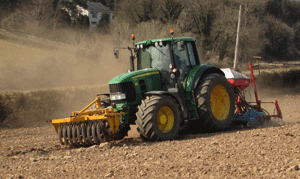Getting it right

The Recommended list produced from AFBI trials provides information on cereal varieties recommended for use in Northern Ireland. Once a suitable variety has been chosen seed rate can be worked out using the calculation below.
Seed rate calculation

Cereal varieties recommended for use in Northern Ireland
Winter wheat
Achieving the optimum plant population is important to maximise yield potential of the crop. Low plant populations are not always detrimental to yield as wheat is able to produce extra tillers to compensate, especially in earlier sown crops. Overly high plant populations are not desirable as there will be an increased lodging risk and disease tends to spread more quickly on overly thick crops. The HGCA benchmark target population is 260plants/m2. At this level there is scope to reduce seed rates if sowing early and the grower is confident of managing the crop to maximise plant survival.
Winter Barley
Whilst Barley can produce extra tillers if sown early, it has less potential to compensate yield for low plant numbers than wheat as it cannot increase grain numbers per ear. This is why the benchmark spring population is higher at 305plants/m2 for Barley
In order to achieve the optimum plant population in spring the seed rate at sowing has to be adjusted in order to take into account changes in expected establishment.
Expected Establishment is affected by a number of factors:
Sowing date
Establishment decreases from over 70% when sown by start of October by approximately 5% per fortnight to less than 50% in December.
Seed vigour
The vigour and germination rate of farm-saved seed can deteriorate over time. Growers are strongly advised to have their seed germination tested prior to planting and adjust seed rate accordingly.
Soil type
Establishment on light sandy soils can be over 90% and down to 65% on loams and clays.
Cultivation
Establishment is higher on fine, well consolidated, trash free seedbeds. Sowing too deep or shallow may reduce emergence.
Damage
Pests or disease can damage seed or small seedlings.
Thousand grain weight
Thousand grain weights can vary considerably between years, different cereal varieties and within batches of the same variety. This is why it is important to drill a known number of seeds rather than a weight of seed.
To highlight the effect differences in thousand grain weight (TGW) can have on seed rates consider the following example.
Two batches of bought in certified winter barley seed have the same germination percentage but different TGW’s of 48.6g for batch A and 41.5g for batch B. The target plant population for both batches is the same 260 plants/m2. Both batches are to be sown on the same day in the same field therefore the expected establishment for both batches is also the same at 85%. Below is the seed rate calculation for both batches:


This shows a difference of 21.8kg/ha in seed needed to achieve the same plant population.
Target plant population
The ideal plant population can be adjusted to individual field requirements. The regional climate or local conditions may justify a higher or lower plant population than the accepted standard. When choosing a target population carefully consider the following:
Likelihood of losses due to frost damage. Barley is more susceptible to winter kill than wheat. Well consolidated seedbeds are at less risk to frost heave but beware rolling on a frost will kill plants.
Potential pest damage e.g. leatherjackets, slugs, birds or grazing wildlife.
Frequency and duration of waterlogging. Barley in particular does not like wet conditions.
Certain varieties have higher overwinter survival rates and differing tillering characteristics.
Seed Dressings
Click to see a HGCA produced summary of the seed treatment options for Wheat and Barley. When choosing a seed dressing consider what are the likely issues for the crop or field in question. Advisory thresholds exist for seed borne diseases in barley and wheat. Consider a Take-all dressing for second wheat (wheat after wheat or barley). Latitude is specifically for this purpose, though other broad purpose dressings containing fluquinconazole also offer protection.
Insecticide seed dressings are useful insurance in a wet autumn when ground or weather conditions may inhibit alternative treatments. Aphid monitoring of migrating aphid numbers gives indication to the severity of the BYDV threat. A multi-purpose insecticide containing dressing will protect seedlings against BYDV vectors and other pests. Clothianidin containing dressings also offer seed and seedling protection against slugs.
Fungicide activity and performance in wheat and barley
Advisory threshold for seed borne diseases in wheat and barley
Aphid Monitoring
Working out Establishment Percentage
Establishment is the percentage of sown plants surviving after emergence. Average crop establishment figures for variables such as soil type, geographic location, crop type or sowing date will be of some use when setting the target plant population. For Improved fine tuning of the seed rate it is best to use historic establishment percentages from your own farm as soil type and location will not vary and establishment practices will be reasonably consistent from year to year.
To work out the plant population take at least four samples (more if variable) across the field. Throw down a quadrat or hoop of known area, count the number of plants inside it and multiply to get the plants/m2. Alternatively use a tape measure to count the number of plants growing along a measured row and use the calculation below as follows:

It is useful to do a plant count once all plants have emerged and again early in the spring. The difference between the autumn and spring figures will give an indication of winter kill. These figures will help in identifying factors which may be contributing to a low establishment percentage. Keeping a record over a number of years will give good justification for adjusting seed rates to fit the specific farm conditions or weather and soil conditions at drilling.
